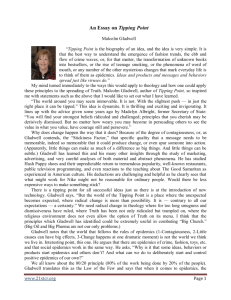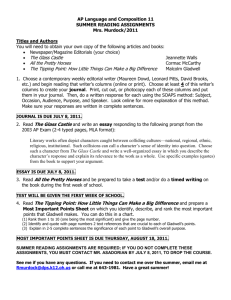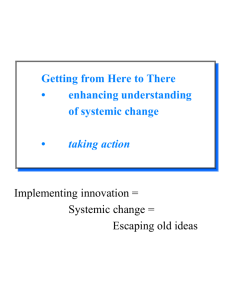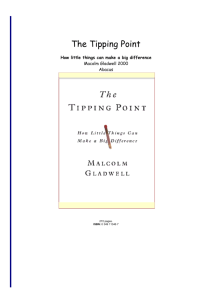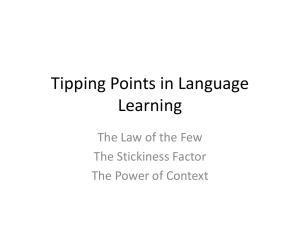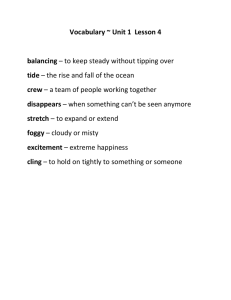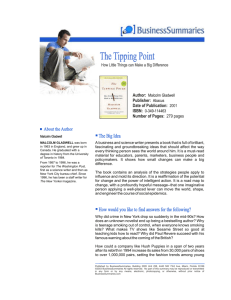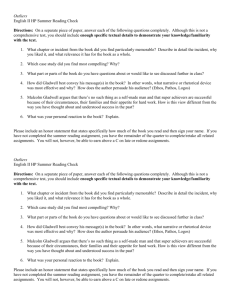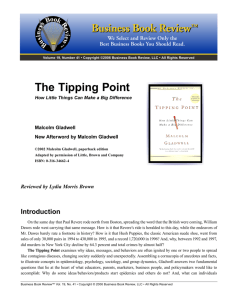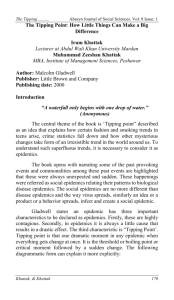G:\packets backup\fact & Info sheets and guidance notes\Fact & Info
advertisement
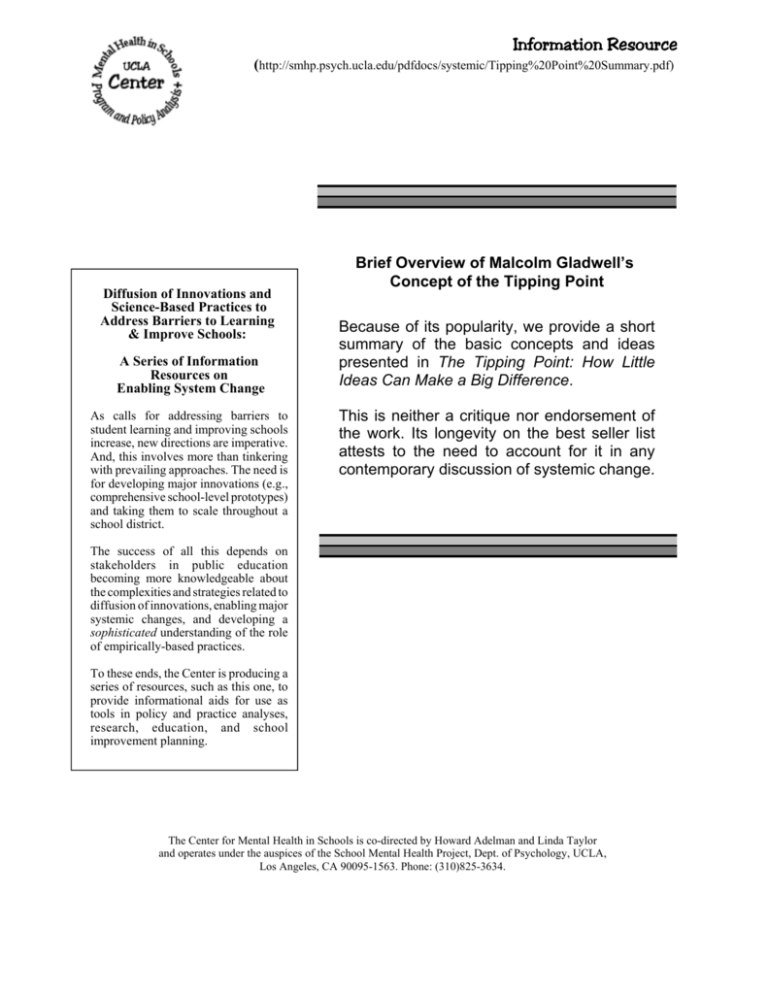
Information Resource (http://smhp.psych.ucla.edu/pdfdocs/systemic/Tipping%20Point%20Summary.pdf) Diffusion of Innovations and Science-Based Practices to Address Barriers to Learning & Improve Schools: A Series of Information Resources on Enabling System Change As calls for addressing barriers to student learning and improving schools increase, new directions are imperative. And, this involves more than tinkering with prevailing approaches. The need is for developing major innovations (e.g., comprehensive school-level prototypes) and taking them to scale throughout a school district. Brief Overview of Malcolm Gladwell’s Concept of the Tipping Point Because of its popularity, we provide a short summary of the basic concepts and ideas presented in The Tipping Point: How Little Ideas Can Make a Big Difference. This is neither a critique nor endorsement of the work. Its longevity on the best seller list attests to the need to account for it in any contemporary discussion of systemic change. The success of all this depends on stakeholders in public education becoming more knowledgeable about the complexities and strategies related to diffusion of innovations, enabling major systemic changes, and developing a sophisticated understanding of the role of empirically-based practices. To these ends, the Center is producing a series of resources, such as this one, to provide informational aids for use as tools in policy and practice analyses, research, education, and school improvement planning. The Center for Mental Health in Schools is co-directed by Howard Adelman and Linda Taylor and operates under the auspices of the School Mental Health Project, Dept. of Psychology, UCLA, Los Angeles, CA 90095-1563. Phone: (310)825-3634. Look at the world around you. It may seem like an immovable, implacable place. It is not. With the slightest push – in just the right place – it can be tipped. Malcolm Gladwell ladwell states that the concept of the Tipping Point helps people understand the many changes (e.g., new ideas, products, messages, behaviors) that happen in everyday life. He thinks of these changes in terms of an “epidemic” such as the spread of viruses. He then formulates change principles in terms of the epidemic metaphor, emphasizing: (1) some things are contagious, (2) little changes can have big effects, and (3) change can happen suddenly when equilibrium is upset (the “tipping” point). G In brief, a Tipping Point is a threshold, critical mass, boiling point moment that leads to sudden, dramatic, radical change (e.g., a geometric progression). With the metaphor of an epidemic as a constant, Gladwell formulates three rules (agents of change) for making sense of the “Tipping Point” • The Law of the Few • The Stickiness Factor • The Power of Context The Law of the Few Mavens link people with and teach them about new information. They amass data and broker information. They provide the message that becomes a social epidemic. “The Law of the Few ... says that one critical factor in epidemics is the nature of the messenger. [Something new] can become highly contagious and tip simply by being associated with a particular kind of person.” Salesmen are persuaders. They are able to win over people who initially are unconvinced. They transact with others verbally and nonverbally. They are able to draw others in and control the transactions. Success of any kind of social epidemic (e.g., word-of-mouth epidemics) is heavily dependent on the involvement of three types of “messengers” with a set of social gifts. Gladwell designates them as Connectors, Mavens, and Salesmen. The three types are not mutually exclusive. He argues that social epidemics can develop from “a small number of these special people” (e.g., a few Salesmen, a Maven, a Connector). The Stickiness Factor Gladwell states that to spark an epidemic, the ideas carried by messengers have to be memorable and capable of moving people to action. “Messengers are what make something spread. But the content of the message matters too. And the specific quality that a message needs to be successful is ... ‘stickiness’.” Stickiness describes ways that messages are systemically engineered (e.g., structured, formatted, packaged) to make them memorable and irresistible and that compel people to take action. Gladwell argues that there are simple (often small and seemingly Connectors are people who know lots of people and have an “impulse” and “a special gift” for relating to others in different “worlds” and can link people together. Knowing many others is seen as a source of significant social power. Connectors are seen by Gladwell as providing the social glue for a social epidemic. 1 trivial) ways to package information that contribute to stickiness. The problem is finding and using such methods effectively. Also important in the process is to avoid “clutter.” to magnify the epidemic potential of a message or idea.” At the same time, he stresses that groups up to 150 can have “real social authority.” So, he offers the “Rule of 150” and quotes Robin Dunbar. Dunbar states: “The figure of 150 seems to represent the maximum number of individuals with whom we can have a genuinely social relationship, the kind of relationship that goes with knowing who they are and how they relate to us.” Bigger groups require imposing complicated hierarchies and rules and regulations and formal measures to ensure loyalty and cohesion. Below 150, these goals can be achieved informally. Above 150, there are structural impediments to the ability of the group to agree and act as one voice and thus to organize the group in moving toward the Tipping Point. Gladwell cautions that even relatively small increases beyond 150 create significant social and intellectual contextual burdens related to the Tipping Point. The Power of Context Gladwell’s third essential change consideration is that: “Epidemics are sensitive to the conditions and circumstances of the times and places in which they occur.” Indeed, he argues that people are “exquisitely sensitive” to these environmental matters and that contextual changes that are capable of tipping an epidemic often are not intuitive and small environmental changes can be important in tipping epidemics. Moreover, some situations are so powerful they overwhelm personal predispositions. In addition, Gladwell stresses that groups play a critical contextual role in social epidemics (e.g., group dynamics, peer pressure, social norms). He states: “Small, close-knit groups have the power Two Fundamental “Lessons” Gladwell stresses two fundamental “lessons” of the Tipping Point view of change: (1) “Starting epidemics requires concentrating resources on a few key areas. The Law of the Few says that Connectors, Mavens, and Salesmen are responsible for starting word-of-mouth epidemics [so] resources ought to be solely concentrated on those three groups.” (2) “The theory of the Tipping Point requires ... that we reframe the way we think about the world. ... The world ... does not accord with our intuition. Those who are successful at creating social epidemics do not just do what they think is right. They deliberately test their intuitions.” Gladwell concludes that, underlying successful epidemics “is a bedrock belief that change is possible, that people can radically transform their behavior or beliefs in the face of the right kind of impetus. ... Tipping Points are a reaffirmation of the potential for change and the power of intelligent action.” 2 A Few Other Related Center Documents and Publications Systemic Change for School Improvement: Designing, Implementing, and Sustaining Prototypes and Going to Scale. Online at http://smhp.psych.ucla.edu/pdfdocs/systemic/systemicreport.pdf Toward a Scale-Up Model for Replicating New Approaches to Schooling. Online at http://smhp.psych.ucla.edu/publications/06%20toward%20a%20scale%20up%20model% 20for%20replicating%20new%20approaches.pdf Scaling-Up Reforms Across A School District. Online at http://smhp.psych.ucla.edu/publications/21%20SCALING-UP%20REFORMS%20ACR OSS%20A%20SCHOOL.pdf Organization facilitators: A change agent for systemic school and community changes. http://smhp.psych.ucla.edu/pdfdocs/Report/orgfacrep.pdf On Sustainability of Project Innovations as Systemic Change. Online at http://smhp.psych.ucla.edu/publications/45%20on%20sustainability%20of%20project%2 0innovations%20as%20systemic%20change.pdf New Initiatives: Considerations Related to Planning, Implementing, Sustaining, and Going-to-Scale. Online at http://smhp.psych.ucla.edu/pdfdocs/briefs/sustainbrief.pdf Sustaining School and Community Efforts to Enhance Outcomes for Children and Youth: A Guidebook and Tool Kit. Online at http://smhp.psych.ucla.edu/pdfdocs/sustaining.pdf Getting From Here to There: A Guide book for The Enabling Component. Online at http://smhp.psych.ucla.edu/pdfdocs/enabling/gettingfromhere.pdf The Center’s Series of Information Resources on Enabling System Change Diffusion of Innovations and Science-Based Practices to Address Barriers to Learning & Improve Schools >Brief Overview of a Major Review by L.W. Green, et al. (2009) entitled: Diffusion Theory and Knowledge Dissemination, Utilization, and Integration in Public Health >Brief Overview of Major Concepts from E.M. Rogers’ Work on Diffusion of Innovations >Brief Overview of Malcolm Gladwell’s Concept of the Tipping Point >Some Key Terms Related to Enabling System Change >Systemic Change for School Improvement >Change Agent Mechanisms for School Improvement: Infrastructure not Individuals >System Change and Empirically-Supported Practices: The Implementation Problem >Policy Implications for Advancing Systemic Change for School Improvement >Some Key References Related to Enabling System Change >Dissemination Focused on Diffusion: Some Guidelines >Diffusion: In Pursuit of Action >Excerpts from Child Trends' series of Research-to Results Briefs on Adopting, Implementing, Sustaining, and Replicating Evidence-Based Practices >Making and Disseminating Recommendations is Not Sufficient >Intro to Multi-Level Community Based Culturally Situated Interventions 3

